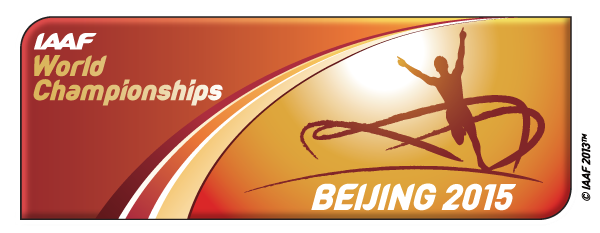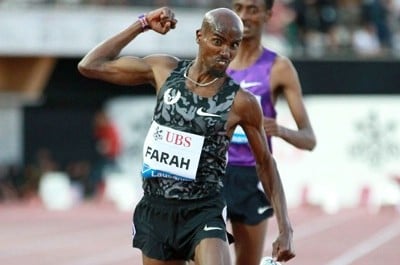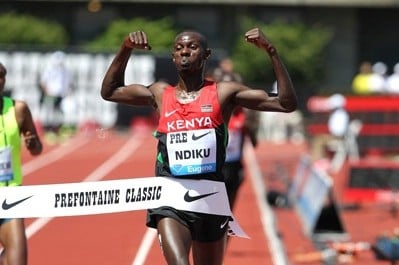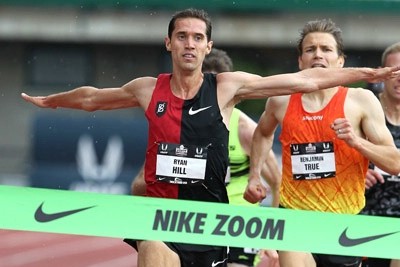2015 Worlds Men’s 5,000 Preview: Should we hand Mo Farah the gold right now? Can Ryan Hill, Ben True or Galen Rupp become the first American-born athlete to medal in history?
By LetsRun.com
August 25, 2015
After Mo Farah‘s heroics in Saturday night’s 10,000, he enters the 5,000 meters at the 2015 IAAF World Championships (prelims Wednesday, 9:35 p.m. ET; final Saturday, 7:30 a.m. ET) as the heavy favorite. There were already plenty of reasons to like Farah going into this one: his three straight global titles at 5,000, his decimation of the world’s top 5,000 runners in Lausanne on July 9, his 3:28 1500 in Monaco a week later. But it’s his victory in the 10,000 that the 5,000 field should find most discouraging. In that race, three extremely fit Kenyans teamed up in an attempt to defeat Farah and still came up short. Perhaps some of the 5,000 guys could try the same tactic again, hoping that Farah is spent from his 27:01 10,000, but he’ll have had a week to recover (with a prelim in the middle) from that effort, and he’s never shown any ill effects in the past, bouncing back from the 10,000 to win 5,000 gold in 2011, 2012 and 2013. Of course, none of those 10,000s were nearly as fast as the one last weekend. The fastest Farah had ever run at Worlds before 2015 was 27:14, he had to run 27:01 on Saturday.
| 2013 World Champs top five 1. Mo Farah, Great Britain 13:26.98 2. Hagos Gebrhiwet, Ethiopia 13:27.26 3. Isiah Koech, Kenya 13:27.26 5. Edwin Soi, Kenya 13:29.01 |
So the question is, ‘How do you beat the world 10,000 champ who has 3:28 1500 speed in a 5000?’
Other than hoping he’s not recovered from the 10,000 or hoping that Farah is sick or suffering from food poisoning, realistically the best way is to pray that Farah makes a tactical mistake. Unfortunately for everyone else, one of Farah’s underrated skills is his ability to adjust and learn from past errors. In the 10,000 final at Worlds in 2011, Farah went too hard too early and paid for it as Ibrahim Jeilan ran him down in the home stretch. He hasn’t made that mistake again at Worlds or the Olympics — though he’ll often move to the lead with more than 400 left, he never hits top gear until he absolutely has to, usually some time during the last 200.
Earlier this year, Farah made another tactical misstep in the Diamond League opener in Doha, responding too hard to an aggressive late-race move with 600 to go made by then-17-year-old Ethiopian Yomif Kejelcha. That opened the door for Hagos Gebrhiwet to come through and hand Farah his first loss on the track since July 2013. So what did Farah do when Kejelcha moved hard two months later in Lausanne? He let him go by, tracking him until the final 100, where Farah blew his doors off.
| 2015 five fastest performers (among men entered) 1. Yomif Kejelcha, Ethiopia 12:58.39 2. Hagos Gebrhiwet, Ethiopia 12:58.69 3. Imane Merga, Ethiopia 12:59.04 4. Ali Kaya, Turkey 13:00.31 5. Illias Fifa, Morocco 13:05.61 |
There’s really not a style of race that doesn’t suit Farah — he could win this thing in 12:50 or 14:50 — but the closer the race moves toward one of those extremes, the greater his chances of losing. Farah is clearly extremely fit this year, but with the 10,000 in Farah’s legs, if the pace was super hot, perhaps he would be vulnerable as he only has the 5th best pb in the field at 12:53.11. The problem is so far this year only three people in the world have broken 13:00 and no-one has shown anything indicative of sub-12:50 shape.
The other option is for the race to go extremely slowly — say a winning time in the 13:50 range. All of the guys in the final will be able to run a 52- or 53-second 400, but very few can manage it at the end of a 5,000-meter race. But as we saw in the women’s 10,000 on Monday, the slower a race goes, the more people hang around, which can lead to an unlikely outcome, such as a medal for Emily Infeld. Of course, astute fans will point out that even in a slow race, the favorite (Vivian Cheruiyot) still came through for gold. And that’s still the most likely outcome if this 5,000 goes slow. Farah will know how fast he’s running, and if it’s extremely slow, he’ll make sure he gets to the front early enough to be in the best position in the final 200. Plus he’d be foolish to let it turn into a 400, just go to the front and turn it into a 1500 and it’s hard to lose as a 3:28 1500 runner. The only hope for the rest of the field would be to keep it really slow and prevent Farah getting to the front when he wants to. That would allow someone like Gebrhiwet, or perhaps Caleb Ndiku, to move before Farah is ready, giving them a precious headstart that could be enough to take Farah down in a tactical race.
Ndiku, on paper, is the best hope at preventing a Farah victory. Kejelcha has flashed incredible talent, but he turned 18 (officially) earlier this month and we don’t know whether he can handle a long summer of racing without burning out. Back when he was attacking Farah with reckless abandon in Doha on May 15th, we doubt he was thinking, “I want to make sure I’m in great shape in late August.” He was probably simply trying to win and take home his first $10,000 pay check. Gebrhiwet, as the only man to beat Farah this year, has a shot to win in Beijing, but he hasn’t raced since June 4 (when he was third in the Rome DL 5,000). We have no idea what kind of shape he’s in.
There are questions surrounding Ndiku as well, and he is by no means a favorite over Farah. But he was clearly the world’s best 5,000 runner last summer, earning Diamond League, Commonwealth and African titles, in addition to 3,000 wins at World Indoors and the Continental Cup. He never got a chance to race Farah, but all indications are that he would have given him a better fight than anyone else. Ndiku has also got terrific 1500 speed (3:29.50 PB, which he ran to finish third behind Asbel Kiprop and Farah in Monaco two years ago) and has run 3:49.77 for the mile.
Coming into the year, he was clearly a very dangerous threat to Mo Farah.
The problem is that, like Gebrhiwet, we don’t know exactly what shape Ndiku is in, though unlike Gebrhiwet, he has raced recently. Ndiku underwent knee surgery earlier this year and he missed the first few months of the outdoor season as a result, making his debut in Lausanne on July 9. However, he fell with 600 to go in that race just as the pace was accelerating and wound up 11th in 13:32. In his next race, a 3,000 in Monaco ib July 17th, Ndiku looked good taking the win in a world #2 7:35.13, but while he beat some solid runners (2013 bronze medalist Isiah Koech, 2008 Olympic bronze medalist Edwin Soi), Farah and Kejelcha were not among them.
And that’s all we have to go on in terms of races (as the reigning DL champ, Ndiku had a bye into worlds and Ndiku skipped the Kenyan Trials) – one in which he fell, and one in which he looked good. Ndiku probably has the best hope of upsetting Farah simply because of the unknown. But given what we do know, Farah has to be the convincing favorite.
How About the Americans?
As you may be able to tell, there’s some uncertainty in the 5,000-meter ranks behind Farah this year. And that helps the Americans, Ryan Hill, Ben True and Galen Rupp. None of them have been among the very best in the world at a global championship 5,000 (Rupp has been 9th, 7th and 8th in his three global 5,000 finals; Hill was 10th in Moscow, and True will make his World Champs debut in Beijing), but they’ve all shown the ability to close well in the past.
Rupp has 3:50 speed and an Olympic silver medal at 10,000. However, he’s never excelled at 5000 – remember, he came within .07 of missing out on the U.S. team entirely at 5,000 after a draining 10,000 at USAs – and he’s struggled mightily to close in his last two races – the Flotrack Throwdown mile and the World Champs 10,000 (though obviously that came in a race in which he ran 27:08 — it would have been hard for anyone to close quickly off that pace). Plus did running 27:08 in the heat of Beijing take something out of Rupp?
Those are the negatives on Rupp. The two big positives are large. One, Rupp ran extremely well on the DL circuit at 5,000 last year (3rd in Oslo and Zurich, 4th in Paris and Stockholm). Two, and this is the biggest, Rupp’s 27:08 10,000 was a TREMENDOUS performance. Sure, you can ask if he’s properly recovered from it, but as we posted on the messageboard after the race, Rupp ran a fantastic race. Back in 2009, when Dathan Ritzenhein ran 12:56 for 5000 on August 29, many people were asking, ‘Where did that come from?’ Not us. 11 days earlier, with little fanfare, he’d run 27:22 for sixth 10,000 in heat of Berlin at Worlds, something we figured had to worth something close to 27 flat in ideal conditions. Rupp’s 27:08 for 5th in the heat of Beijing is definitely worth a sub-27. The close may not be there but he’s in great shape and could do well if the pace is honest.
If the pace is slow, the outlook is more optimistic for Hill and True, especially considering they’ll be entering the 5,000 fresh. True outkicked Olympic medalists Thomas Longosiwa and Nick Willis in New York on June 13 and has said repeatedly that if he’s still there at the bell, he believes he can summon a 54-second final lap, which could be enough to earn a medal. The prospects are arguably better for Hill, who outkicked True to win USAs and has shown the best top-end speed of any American 5,000 runner, as evidenced by his 25.77 final 200 to win USA indoors in the 2-mile in February (outkicking 1500 specialist Ben Blankenship in the process).
True and Hill will be rooting for different race styles. Last week, True told Runner’s World the following:
“An ideal situation is that there’d be a relatively quick race, more in the 13:05-13:10 range, coming down to a hard kick. I think at that speed my kick will be just as strong as other people’s. It comes down to having good position and staying out of most of the surging and fartleking games, and conserving energy for the last 600 meters.”
In a race that fast, the medalists aren’t going to close much faster than 54 seconds, if that, and True clearly believes that he can run the last lap in 54 seconds unless the pace is truly fast (sub-13). And in any championship race, whether it’s 13:05 or 13:45, positioning is important (obviously moreso for the latter scenario) and True is generally good at putting himself in the right spot. The problem for True is he closed a 13:29 race in 54 high (albeit in very hot and sunny conditions) whereas someone like Kejelcha closed a 12:58 race in 54 low.
Hill, whose PB is over 10 seconds slower than True’s (13:02 to 13:14), should be rooting for a 13:30 race or slower. His two national titles, the indoor 2-mile and the outdoor 5,000, were both very slow (8:26 and 13:50), which played into his greatest advantage — his top-end speed. At USA indoors, Hill said he wanted to wait until “the last possible moment” to take the lead, and that’s the right way to think about it. The longer he can put off kicking, the stronger his chances become. You could even argue that if it’s really slow and still tight with 200 to go, Hill actually becomes favored over most of the Africans — again, he closed USA indoors in 25.77.
If an American does medal, please realize it will be historic as an American born athlete has never medalled in the 5000 at Worlds (Kenyan born Bernard Lagat has won 3). If one does this year, medal, we think it most likely be a scenario like 2007 when the American born Matt Tegenkamp came within .03 of medalling. In that race, 5 African born runners were battling for the win with 250 to go and three of them tired in the homestretch and Tegenkamp passed them all save Moses Kipsiro. Wath the last 250 of that race here:
So no matter how the race plays out, there should be at least one American in medal contention (and perhaps more if Rupp can somehow overcome that grueling 10,000). That’s good news and should make for an exciting race, especially if Farah drains the drama up front by doing what he always does in championship finals.
LRC Prediction: 1) Farah 2) Ndiku 3) Kejelcha
Give us your thoughts – MB: Official 2015 Worlds Men’s 5000 Pre-Race Discussion Thread – Will True, Hill or Rupp win a historic 1st medal for USA? – and vote in our polls below:
|
[gravityform action=”polls” id=”253″ mode=”poll” cookie=”1 month” show_results_link=”false” display_results=”true” percentages=”true” counts=”false” ajax=”true”] |
| [gravityform action=”polls” id=”254″ mode=”poll” cookie=”1 month” show_results_link=”false” display_results=”true” percentages=”true” counts=”false” ajax=”true”] |






